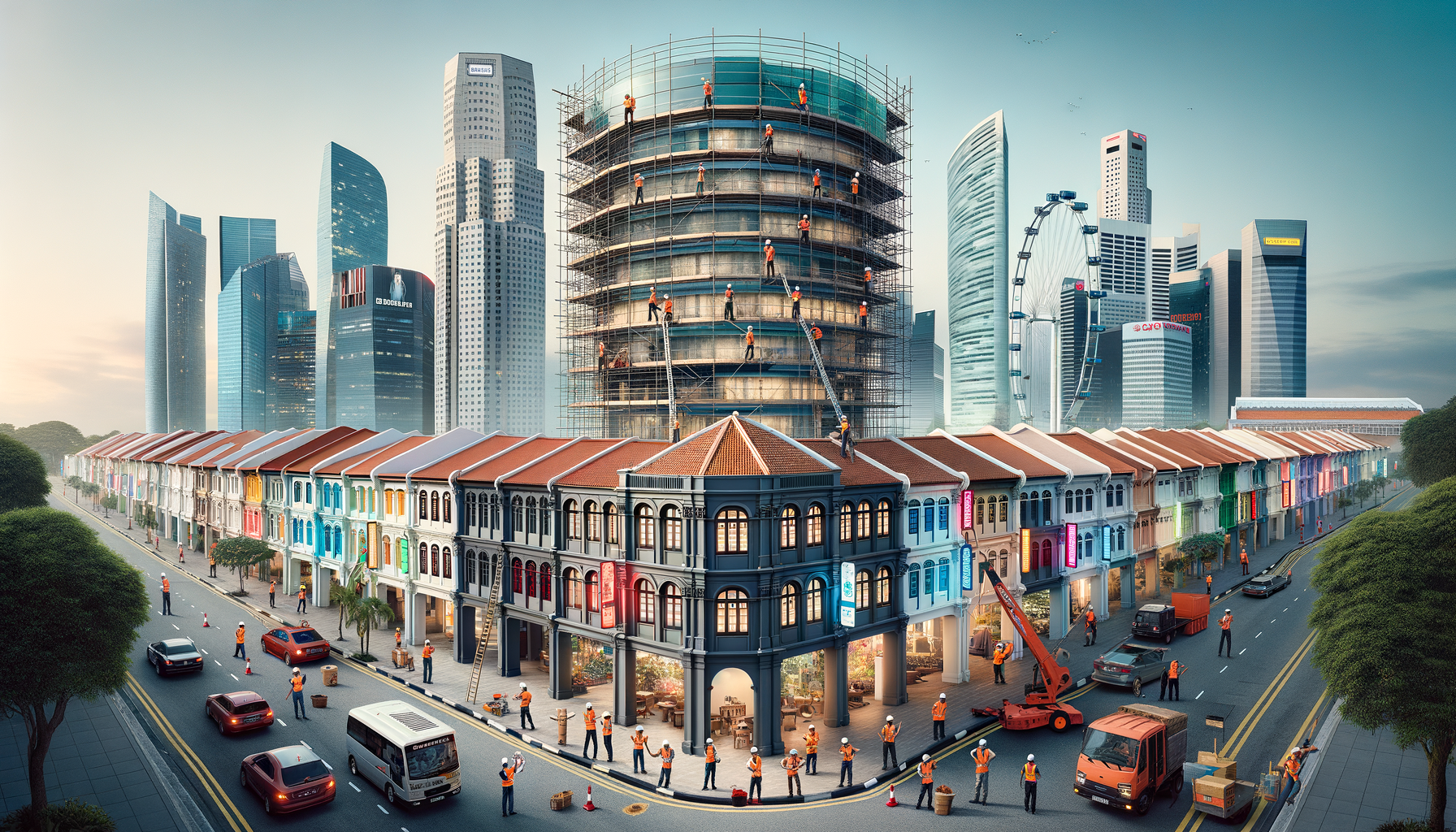Welcome to the world of commercial property alterations in Singapore! 🏙️ Did you know that in 2022, Singapore’s commercial real estate market saw a whopping $9.3 billion in investment volume? That’s a lot of buildings getting makeovers! Whether you’re a property owner, developer, or just curious about the process, this guide will walk you through the ins and outs of transforming commercial spaces in the Lion City. From navigating complex regulations to implementing cutting-edge design trends, we’ve got you covered. So, let’s dive in and explore the exciting realm of commercial property alterations in Singapore!
Understanding the Basics of Commercial Property Alterations
When it comes to commercial property alterations, there’s a lot to unpack. Let’s start with the basics, shall we?
First off, what exactly do we mean by “commercial property alterations”? Well, it’s pretty much what it sounds like – any changes or modifications made to a commercial building or space. These can range from minor tweaks to major overhauls.
Now, there are three main types of alterations you’ll come across:
- Structural alterations: These are the big guns – think knocking down walls or adding new floors.
- Cosmetic alterations: These are your facelifts – fresh paint, new flooring, that sort of thing.
- Functional alterations: These focus on improving how the space works – like updating electrical systems or improving accessibility.
So, why do businesses go through the hassle of altering their properties? There are plenty of reasons! Maybe they’re expanding and need more space, or perhaps they’re rebranding and want a fresh look. Sometimes it’s about improving energy efficiency or complying with new regulations.
Of course, these projects don’t happen in a vacuum. There’s a whole cast of characters involved – property owners, tenants, architects, contractors, and let’s not forget the government agencies overseeing everything. It takes a village, as they say!
Navigating Singapore’s Regulatory Landscape
Now, if you’re planning alterations in Singapore, buckle up! The regulatory landscape can be a bit of a maze, but don’t worry – we’ll break it down for you.
Singapore takes its building codes and regulations seriously, and for good reason. These rules ensure that buildings are safe, accessible, and up to standard. But what does this mean for you? Well, it means you’ll need to do your homework before you start swinging that sledgehammer.
There are several government agencies you’ll need to get cozy with. The Building and Construction Authority (BCA) is your main port of call, but depending on your project, you might also need to deal with the Urban Redevelopment Authority (URA) or the Singapore Civil Defence Force (SCDF).
And let’s talk permits. Oh boy, the permits! Depending on the scope of your alterations, you might need a variety of licenses and approvals. There’s the Building Plan approval, the Structural Plan approval, and don’t forget about the Fire Safety Certificate.
But it’s not all red tape and bureaucracy. These regulations are there to ensure that your alterations are safe, compliant, and accessible to everyone. So while it might seem like a headache now, you’ll thank them later when your newly altered space is up to code and running smoothly.
Planning Your Commercial Property Alteration Project
Alright, so you’ve decided to take the plunge and alter your commercial property. Exciting times! But before you start knocking down walls, let’s talk planning.
First things first: you need to know what you’re getting into. That means conducting a feasibility study and needs assessment. What do you want to achieve with these alterations? What are the potential challenges? Is it even possible given your budget and timeline?
Speaking of budgets and timelines, let’s get real for a moment. It’s easy to get carried away with grand visions, but you need to set realistic expectations. Remember, in the world of construction, things rarely go exactly as planned. Always build in some wiggle room for unexpected costs and delays.
Now, unless you’re a jack-of-all-trades (and let’s face it, even if you are), you’re going to need some help. This is where hiring the right professionals comes in. You’ll want a skilled architect to design your alterations, a reliable contractor to carry them out, and possibly consultants for specialized aspects like structural engineering or interior design.
Finally, pull all this together into a detailed project plan. This should outline every stage of the alteration process, from initial designs to final inspections. Think of it as your roadmap – it’ll help keep everyone on the same page and moving in the right direction.
Design Considerations for Commercial Property Alterations
When it comes to design, commercial property alterations are a balancing act. On one hand, you want your space to look great and reflect your brand. On the other hand, it needs to be functional and practical for day-to-day operations. It’s not always easy, but finding that sweet spot is key to a successful alteration.
These days, sustainability is more than just a buzzword – it’s a necessity. Incorporating energy-efficient features into your alterations isn’t just good for the planet; it can also save you money in the long run. Think LED lighting, smart HVAC systems, or even solar panels if you’re feeling ambitious.
And let’s not forget the elephant in the room – or should I say, the virus in the air? The COVID-19 pandemic has changed the way we think about workspaces. Your alterations might need to consider things like improved ventilation, touchless technologies, or flexible spaces that allow for social distancing.
Lastly, if you’re altering an older building, you might need to consider heritage elements. Singapore has a rich architectural history, and preserving some of these features can add character and charm to your space. It’s about finding that balance between old and new, tradition and innovation.
Overcoming Common Challenges in Commercial Property Alterations
Let’s face it – no matter how well you plan, challenges are bound to pop up during your alteration project. But don’t worry, forewarned is forearmed!
One common hurdle is unexpected structural issues. You might start pulling up floorboards only to find rotting joists underneath. Or maybe that wall you wanted to knock down turns out to be load-bearing. These surprises can throw a wrench in your plans, but staying flexible and having contingency funds can help you roll with the punches.
If you’re altering a space that’s still in use, minimizing disruptions to ongoing business operations can be tricky. It might mean working after hours, phasing the project, or temporarily relocating some operations. Communication is key here – make sure everyone knows what to expect and when.
Budget overruns are another common headache. Costs have a way of creeping up, whether it’s due to unexpected issues, changes in material prices, or scope creep. Keep a close eye on expenses and don’t be afraid to make tough decisions if needed.
Lastly, if you’re a landlord altering a tenanted property, you’ll need to navigate tenant concerns carefully. Keep them informed, address their worries promptly, and try to minimize inconvenience where possible. Remember, maintaining good relationships is crucial for the long-term success of your property.
Implementing Best Practices for Successful Alterations
Alright, let’s talk about how to knock your alteration project out of the park. First up: communication. I can’t stress this enough – clear, consistent communication with all stakeholders is crucial. Whether it’s your contractors, tenants, or government officials, keeping everyone in the loop can prevent misunderstandings and keep your project running smoothly.
Quality control is another biggie. You want your alterations to stand the test of time, right? That means keeping a close eye on the work being done and not cutting corners. Regular site inspections, material checks, and adherence to industry standards are all part of the game.
Now, we’re living in the 21st century, so why not take advantage of it? Technology can be a huge help in the alteration process. From 3D modeling software that lets you visualize changes before they’re made, to project management apps that keep everyone on the same page, embracing tech can streamline your project significantly.
Lastly, don’t underestimate the importance of good record-keeping. Document everything – contracts, permits, changes, inspections, the works. It might seem tedious now, but trust me, you’ll thank yourself later if any issues crop up down the line.
Post-Alteration Considerations
Congratulations! Your alterations are complete. But hold off on the champagne for just a moment – there are still a few things to take care of.
First, you’ll need to obtain all necessary certifications and approvals. This might include a new Fire Safety Certificate or a Certificate of Statutory Completion. These documents aren’t just formalities – they’re your proof that your alterations are up to code and safe for use.
Next up: inspections and quality checks. Go through your altered space with a fine-tooth comb. Are all the finishes up to standard? Are all systems working correctly? It’s much easier to address any issues now than weeks or months down the line.
Don’t forget about maintenance. Your newly altered space might have new systems or features that require specific upkeep. Create a comprehensive maintenance plan to keep everything in tip-top shape.
Finally, it’s time to show off your hard work! Whether you’re a business owner looking to impress clients or a landlord hoping to attract new tenants, marketing your newly altered property can help you reap the rewards of your investment. Professional photos, virtual tours, or even an open house event can help showcase your space in its best light.
And there you have it! With careful planning, diligent execution, and thorough follow-up, your commercial property alteration project can be a resounding success. Here’s to your newly improved space!
Conclusion
Whew! We’ve covered a lot of ground in this ultimate guide to commercial property alterations in Singapore. From understanding the basics to navigating regulations and implementing best practices, you’re now equipped with the knowledge to tackle your next alteration project with confidence. Remember, successful alterations require careful planning, expert execution, and a keen eye for detail. So, whether you’re revamping a single office or transforming an entire building, keep these insights in mind to ensure your commercial property alteration is a resounding success. Ready to get started on your own alteration journey? Let’s make those commercial spaces shine! 🌟





